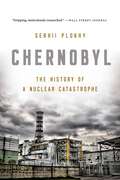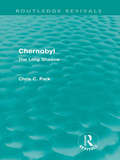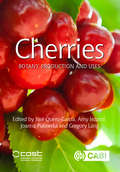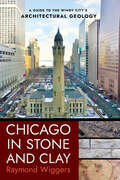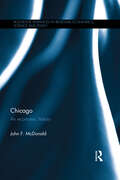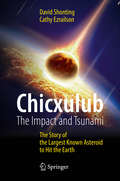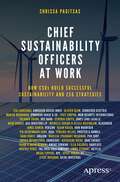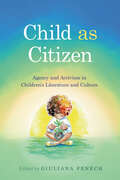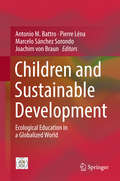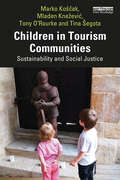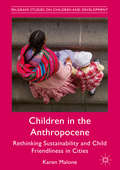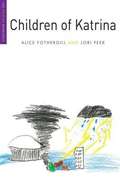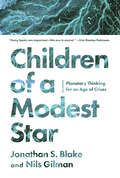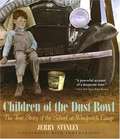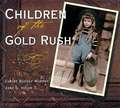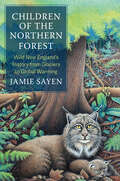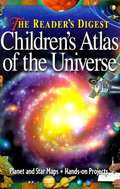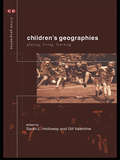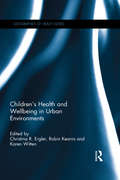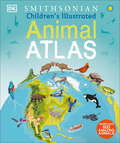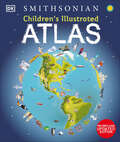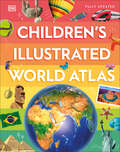- Table View
- List View
Chernobyl: The History of a Nuclear Catastrophe
by Serhii PlokhyFrom a preeminent historian of Eastern Europe, the definitive history of the Chernobyl nuclear disaster On the morning of April 26, 1986, Europe witnessed the worst nuclear disaster in history: the explosion of a reactor at the Chernobyl Nuclear Power Plant in Soviet Ukraine. Dozens died of radiation poisoning, fallout contaminated half the continent, and thousands fell ill. In Chernobyl, Serhii Plokhy draws on new sources to tell the dramatic stories of the firefighters, scientists, and soldiers who heroically extinguished the nuclear inferno. He lays bare the flaws of the Soviet nuclear industry, tracing the disaster to the authoritarian character of Communist party rule, the regime's control of scientific information, and its emphasis on economic development over all else. Today, the risk of another Chernobyl looms in the mismanagement of nuclear power in the developing world. A moving and definitive account, Chernobyl is also an urgent call to action.
Chernobyl: The Long Shadow (Routledge Revivals)
by Chris ParkFirst published in 1989, Chernobyl: The Long Shadow offers a balanced review of what happened there, why and how it happened, and what the main lessons and implications of the accident are. It looks back on events during and after the disaster, in particular reviewing how it and the radiation fallout were dealt with in different countries and looks forward to how the incident might affect the nuclear power industry around the world. The book explores the significance of the accident within the Soviet Union, considers its impact on public confidence in nuclear power, and reviews what improvements are necessary in emergency planning throughout the rest of the world. It is written from an inter-disciplinary perspective; based on detailedscienctific research, which is described in non-specialist terms, it considers themes like attitudes to nuclear power and political reaction to the accident itself. It sets the Chernobyl accident into a proper context. Chernobyl: The Long Shadow will appeal to students and teachers of geography, environmental science, international politics, nuclear physics, and to anyone interested in current affairs and environmental problems.
Cherries
by J. Quero-García Amy Iezzoni Joanna Puławska Gregory LangSweet and sour cherries (Prunus avium and Prunus cerasus) are important fruit crops for which demand is high and growing. A significant number of new varieties, rootstocks and training systems have been released or developed in recent years in order to improve the efficiency and profitability of cherry orchards. Cherries: Botany, Production and Uses covers the genetics, ecophysiology, production, protection and uses of cherries. Presenting up-to-date scientific data and applied information, this book is invaluable for researchers, teachers and all professionals working in the cherries value chain.
Chicago Calamities: Disaster in the Windy City (Disaster Ser.)
by Gayle SoucekFire and flood, train wreck and tornado—a look at the many disasters Chicago has endured over the years, with photos and illustrations. The story of Chicago is often likened to that of a phoenix rising out of the ashes of the Great Fire. Yet that infamous event was only part of the destruction that has shaped Chicago&’s identity. This unique history explores the calamities that have befallen the Windy City, such as the 1954 killer water surge that swept in on a calm summer day; the 1967 tornado that ripped through rush hour traffic; the 1886 Haymarket Square riot that put Chicago on the anarchist map; and many other acts of nature and human folly. As you witness a fireproof theater burn, a flood rise up without rain, and one of the greatest maritime disasters occur within city limits, you&’ll gain a new appreciation for how this city has endured through unexpected tragedies and produced many unlikely heroes.
Chicago in Stone and Clay: A Guide to the Windy City's Architectural Geology
by Raymond WiggersChicago in Stone and Clay explores the interplay between the city's most architecturally significant sites, the materials they're made of, and the sediments and bedrock they are anchored in. This unique geologist's survey of Windy City neighborhoods demonstrates the fascinating and often surprising links between science, art, engineering, and urban history. Drawing on two decades of experience leading popular geology tours in Chicago, Raymond Wiggers crafted this book for readers ranging from the region's large community of amateur naturalists, "citizen scientists," and architecture buffs to geologists, architects, educators, and other professionals seeking a new perspective on the themes of architecture and urbanism. Unlike most geology and architecture books, Chicago in Stone and Clay is written in the informal, accessible style of a natural history tour guide, humanizing the science for the nonspecialist reader. Providing an exciting new angle on both architecture and natural history, Wiggers uses an integrative approach that incorporates multiple themes and perspectives to demonstrate how the urban environment presents us with a rich geologic and architectural legacy.
Chicago: An economic history (Routledge Advances in Regional Economics, Science and Policy)
by John F. McDonaldChicago went from nothing in 1830 to become the second-largest city in the nation in 1900, while the Midwest developed to become one of the world’s foremost urban areas. This book is an economic history of the Chicago metropolitan area from the 1820s to the present. It examines the city in its Midwestern region and compares it to the other major cities of the North. This book uses theories of the economics of location and other economic models to explain much of Chicago’s history. Chicago maintained its status as the second-largest city through the first decades of the 20th century, but rapid growth shifted to the Sunbelt following World War II. Since the 1950s the city’s history can be divided into four distinct periods; growth with suburbanization (1950-1970), absence of growth, continued suburbanization, and central city crisis (1970-1990), rebound in the 1990s, and financial crisis and deep recession after 2000. Through it all Chicago has maintained its position as the economic capital of the Midwest. The book is a synthesis of available literature and public data, and stands as an example of using economics to understand much of the history of Chicago. This book is intended for the college classroom, urban scholars, and for those interested in the history of one of world’s foremost urban areas.
Chicxulub: The Story of the Largest Known Asteroid to Hit the Earth (Springer Praxis Books)
by Cathy Ezrailson David ShontingThis book tells the story of the catastrophic impact of the giant 10 Km asteroid Chicxulub into the ancient Gulf of Mexico 65. 5 million years ago. The book begins with a discussion of the nature of asteroids and the likelihood of future Earth-impacts. The story then turns to the discovery of a global sediment layer attributed to the fallout from the impact and a piecing together of the evidence that revealed a monster crater, buried under the Gulf. Reviewed is the myriad of geological and fossil evidence that suggested the disastrous sequence of events occurring when a "nuclear-like" explosion ripped through the sea, Earth, and atmosphere, thus forming the mega-crater and tsunami. The aftermath of the Chicxulub's event initiated decades and more of major global climate changes including a "Nuclear Winter" of freezing darkness and blistering greenhouse warming. A chapter is dedicated to the science of tsunamis and their model generation, including a portrayal of the globally rampaging Chicxulub waves. The asteroid's global devastation killed off some 70% of animal and plant life including the dinosaurs. The study of an ancient Cambrian fossil bed suggests how "roll of the dice" events can affect the future evolution of life on Earth. We see how Chicxulub's apparent destruction of the dinosaurs, followed by the their replacement with small mammals, altered forever the progress of human evolution. This book presents a fascinating glimpse through the lens of the natural sciences - the geology, climatology, and oceanography, of the effects of an enormous astronomical event.
Chief Sustainability Officers At Work: How CSOs Build Successful Sustainability and ESG Strategies
by Chrissa PagitsasRead over 20 exclusive, in-depth interviews with chief sustainability officers (CSOs) of Fortune 500 companies such as Amazon, Coca-Cola, and Procter & Gamble and globally recognized brands such as IKEA and Netflix. These CSOs reveal how they deliver positive environmental and social impact through their companies’ core products and services and generate revenue growth while tackling unique leadership, change management, regulatory and stakeholder challenges. Sustainability and environmental, social, governance (ESG) strategies are increasingly central to businesses’ growth strategy and risk management. As a result, the CSO has become more important as a driver of both revenue and strategy. Yet, no two CSOs are alike in their backgrounds, titles or even the scope of their roles. From former Peace Corps volunteers to supply chain experts, these C-suite leaders launch ambitious carbon emissions and net-zero goals, develop new products for a circular economy, target increasing the diversity of their company’s staff, align strategic projects to the UN Sustainable Development Goals and standardize reporting for the SEC, investors and more. What You Will Learn How global multibillion dollar businesses in the United States, Europe and Asia structure their sustainability strategyHow top sustainability executives drive both business value and positive environmental and social impact How CSOs landed in their roles without climbing a traditional career ladder Who This Book Is ForExecutives and board members generally or those establishing a sustainability or ESG strategy; current and aspiring CSOs and ESG leaders; business leaders partnering with sustainability leaders and teams; and students studying the integration of sustainability and business.Advance praise for Chief Sustainability Officers At Work:"Chief sustainability officers play a critical role in supporting the broader business transition to a more just and sustainable global economy. Through dialogue with influential sustainability professionals, Chrissa brings to life the essential role in bridging gaps and helping to eliminate the divide between "traditional" business functions, senior leadership, and the sustainability teams to drive transformational change within their firms." - Mindy Lubber, CEO and President, Ceres "Chief Sustainability Officers at Work, is a fresh new book by seasoned business leader Chrissa Pagitsas that offers succinct ways anyone can implement and achieve ESG goals – whether they own the company or simply aspire to improve its impact on people and the planet. Chrissa roots this book in her own experience leading change within major companies that not only improved the businesses where she worked but improved the markets within which they needed to thrive. This is a must read for a seasoned ESG practitioner as much as it is for the young professional just getting started. Chrissa knows it is imperative we all just get started doing better and she opens up the otherwise dark box of how-tos for all of us to do our part." – Dana Bourland, SVP, The JPB Foundation and author of Gray to Green Communities: A Call to Action on the Housing and Climate Crises.
Child as Citizen: Agency and Activism in Children's Literature and Culture (Children's Literature Association Series)
by Giuliana FenechContributions by Daniela Brockdorff, Nina Christensen, Jill Coste, Katrin Dautel, Justyna Deszcz-Tryhubczak, Giuliana Fenech, Naomi Hamer, Irena Barbara Kalla, Anne Klomberg, Sonali Kulkarni, Elizabeth Leach-Leung, Ann Marie Murnaghan, Emily Murphy, Emilie Owens, Nicola Parker, Patrycja Poniatowska, Meg Rosoff, and Farriba SchulzChild as Citizen: Agency and Activism in Children’s Literature and Culture addresses children’s and young adult agency and activism across literature and culture, demonstrating how these forces influence child citizenship. Contributors to this volume highlight the agentic voices and activist practices that are growing across all spheres of young people’s lives, as well as the challenges to active citizenship that children growing up in unjust sociopolitical contexts face. The volume is interdisciplinary and draws on the sociology of childhood, children’s literature studies, youth culture studies, media, technology, and cultural studies, and Anthropocene, ecofeminist, and disability studies.Agency occurs in and around literature and storytelling, and this collection establishes how it is always influenced by identity as well as geopolitics; how it is both subjective and collective; how it is cultural and embodied; and how, like citizenship, it is not a static status but rather an ongoing negotiation. In this collection, contributors invite readers to consider agency as a system of relations between children themselves, between children and adults, children and institutions, and children and nation-states, as well as between children and the nonhuman. This book reviews the interconnectedness between these relationships and attempts to untangle some of the complications that emerge.
Children and Sustainable Development: Ecological Education in a Globalized World
by Antonio M. Battro Joachim Von Braun Pierre Léna Marcelo Sánchez SorondoThis book addresses the changes in education practices, especially basic education, necessitated by the global challenges of climate change and sustainable development and in a context characterized by increasing poverty and inequality, migration and refugees. Written by a range of international scholars, scientists and grassroots practitioners from Africa, Latin America, Asia (India, China, Malaysia) and Europe, the individual contributions focus on education policies and child development in various social contexts. Case-based experiences from both developed and developing countries provide inspiration and shed new light on the fundamental changes needed to adapt existing school systems and teacher training to face the challenges of the future. In this regard, the need to empower children themselves is emphasized. All contributions are based on a Workshop hosted in November 2015 by the Pontifical Academy of Sciences at the Vatican entitled "Children and Sustainable Development: A Challenge for Education" and follow three other significant events on sustainable development in 2015, namely the publication of Laudato Si', the Encyclical Letter from Pope Francis, the release of the United Nations Sustainable Development Goals, and the COP21 Conference in Paris.
Children and the Geography of Violence: Why Space and Place Matter
by Sheridan BartlettViolence sabotages development, both children’s development and the development of the communities and neighbourhoods they rely on. There is abundant evidence of the deep and lasting harm that can be done. Violence breaks bodies and minds and exerts an insidious influence at every level. The effects are immediate but can also linger, damaging health, trust and capability, traveling through generations. This book argues that it is impossible to understand the violence in young children’s lives or to respond to it adequately without considering how embedded it is within their physical surroundings. The relations of power that are the context for violence within households, within communities and beyond are often expressed through control over space and the material conditions of life. This book links the abstract concept of structural violence to the stark reality of personal harm, drawing on evidence from a range of disciplines and from countries throughout the global South. It explores the dynamics of cramped, insecure housing, poor water and sanitation, neglected neighbourhoods, forced evictions, cities that segregate the rich and the poor, landscapes of conflict and disaster, and discusses their implications for young children. An alternative approach to child protection is proposed, anchored in the actions of organized communities negotiating to challenge inequities, mend their environments and achieve security. There is a fundamental synergy between building community and protecting children. These are not separate agendas. A place that works for children works better for everyone else as well. This book will be essential reading for all those interested in young children in a global context, whether as child protection professionals, or those with a more general interest in children’s rights issues or in cross cultural approaches to child development. It will also be of great interest to students and researchers of development studies, conflict studies, family studies, child development, public health and urban planning.
Children in Tourism Communities: Sustainability and Social Justice
by Tony O’Rourke Marko Koščak Mladen Knežević Tina ŠegotaThis book explores how children living in tourism destinations are particularly susceptible to the impacts of tourism and how they can be included in public policies, programmes and decision-making, focusing particularly on case studies in Europe.Children in Tourism Communities argues that for tourism to exercise its regenerative role and encourage sustainable development, it must be inclusive of all voices, especially children who represent the future generation and will soon become adults with the rights and responsibilities for engaging in and delivering tourism activities. The book is based on original, ground-breaking research assessing the views of children regarding tourism, with a specific focus on sustainable tourism and development. It includes discussion on key case study locations including Croatia, India, Ireland, Malta, Serbia and Slovenia, although the themes, issues and practices have relevance in all tourism destinations worldwide. Through child-centred research, the book evaluates the differences between those living in mass tourism destinations and smaller-scale micro tourism areas. It encourages a rethinking of sustainability as a concept and demonstrates how tourism can be utilised as a tool for achieving the Sustainable Development Goals.This will be an important discussion text for students, academics, and instructors in sustainable tourism and development, destination management, culture and heritage, as well as practitioners engaged in continuing professional development in these areas.
Children in the Anthropocene: Rethinking Sustainability and Child Friendliness in Cities (Palgrave Studies on Children and Development)
by Karen MaloneThis book elaborates the need, in a rapidly urbanizing world, for recognition of the ecological communities we inhabit in cities and for the development of an ethics for all entities (human and non-human) in this context. Children and their entangled relations with the human and more-than-human world are located centrally to the research on cities in Bolivia and Kazakhstan, which investigates the future challenges of the Anthropocene. The author explores these relations by employing techniques of intra-action, diffraction and onto-ethnography in order to reveal the complexities of children's lives. These tools are supported by a theoretical framing that draws on posthumanist and new materialist literature. Through rich and complex stories of space-time-mattering in cities, this work connects children's voices with a host of others to address the question of what it means to be a child in the Anthropocene.
Children of Katrina
by Lori Peek Alice FothergillWhen children experience upheaval and trauma, adults often view them as either vulnerable and helpless or as resilient and able to easily "bounce back. " But the reality is far more complex for the children and youth whose lives are suddenly upended by disaster. How are children actually affected by catastrophic events and how do they cope with the damage and disruption?Children of Katrina offers one of the only long-term, multiyear studies of young people following disaster. Sociologists Alice Fothergill and Lori Peek spent seven years after Hurricane Katrina interviewing and observing several hundred children and their family members, friends, neighbors, teachers, and other caregivers. In this book, they focus intimately on seven children between the ages of three and eighteen, selected because they exemplify the varied experiences of the larger group. They find that children followed three different post-disaster trajectories-declining, finding equilibrium, and fluctuating-as they tried to regain stability. The children's moving stories illuminate how a devastating disaster affects individual health and well-being, family situations, housing and neighborhood contexts, schooling, peer relationships, and extracurricular activities. This work also demonstrates how outcomes were often worse for children who were vulnerable and living in crisis before the storm. Fothergill and Peek clarify what kinds of assistance children need during emergency response and recovery periods, as well as the individual, familial, social, and structural factors that aid or hinder children in getting that support.
Children of a Modest Star: Planetary Thinking for an Age of Crises
by Nils Gilman Jonathan S. BlakeA clear-eyed and urgent vision for a new system of political governance to manage planetary issues and their local consequences. Deadly viruses, climate-changing carbon molecules, and harmful pollutants cross the globe unimpeded by national borders. While the consequences of these flows range across scales, from the planetary to the local, the authority and resources to manage them are concentrated mainly at one level: the nation-state. This profound mismatch between the scale of planetary challenges and the institutions tasked with governing them is leading to cascading systemic failures. In the groundbreaking Children of a Modest Star, Jonathan S. Blake and Nils Gilman not only challenge dominant ways of thinking about humanity's relationship to the planet and the political forms that presently govern it, but also present a new, innovative framework that corresponds to our inherently planetary condition. Drawing on intellectual history, political philosophy, and the holistic findings of Earth system science, Blake and Gilman argue that it is essential to reimagine our governing institutions in light of the fact that we can only thrive if the multi-species ecosystems we inhabit are also flourishing. Aware of the interlocking challenges we face, it is no longer adequate merely to critique our existing systems or the modernist assumptions that helped create them. Blake and Gilman propose a bold, original architecture for global governance—what they call planetary subsidiarity—designed to enable the enduring habitability of the Earth for humans and non-humans alike. Children of a Modest Star offers a clear-eyed and urgent vision for constructing a system capable of stabilizing a planet in crisis.
Children of the Dust Bowl: The True Story of the School at Weedpatch Camp
by Jerry StanleyThis true story took place at the emergency farm-labor camp immortalized in Steinbeck's The Grapes of Wrath. Ostracized as "dumb Okies," the children of Dust Bowl migrant laborers went without school--until Superintendent Leo Hart and 50 Okie kids built their own school in a nearby field. The story is inspiring, and Stanley has recorded the details with passion and dignity. An excellent curriculum item.
Children of the Gold Rush
by Claire Rudolf Murphy Jane G. HaighChildren of the Gold Rush portrays the lives of the indomitable kids who first came to Alaska and the Yukon Territory. In a land where freezing, dark winters and mosquito-filled summers challenged even the hardiest pioneers, the children had to be as tough as the adults and quick to adapt to new conditions -- learning to eat caribou and moose and dressing in fur. Some children left after a few years; others stayed and raised their own children in the frontier.
Children of the Northern Forest: Wild New England's History from Glaciers to Global Warming (Yale Agrarian Studies Series)
by Jamie SayenThis no-holds-barred narrative of the failure of conservation in northern New England&’s forests envisions a wilder, more equitable, lower-carbon future for forest-dependent communities Jamie Sayen approaches the story of northern New England&’s undeveloped forests from the viewpoints of the previously unheard: the forest and the nonhuman species it sustains, the First Peoples, and, in more recent times, the disenfranchised human voices of the forest, including those of loggers, mill workers, and citizens who, like Henry David Thoreau, wish to speak a kind word for nature. From 1988 to 2016 paper companies sold their timberlands and closed seventeen paper mills in northern New England. Policy makers ceded veto power to large absentee landowners, who tried to preserve the status quo by demanding additional tax cuts and other subsidies for economic elites. They vetoed measures designed to restore and preserve forest health; at present, about half of the former industrial forests are classified as degraded, and the regional economy continues to be trapped in low-value commodity markets. This book operates as a case study of how a rural resource region can respond to a global economy responsible for climate change, habitat loss and degradation, and environmental injustice. Sayen offers a blueprint for restoring vast wildlands and transitioning to a lower-carbon, high-value-adding, local economy, while protecting the natural rights of humans, nonhumans, and unborn generations.
Children's Atlas of the Universe
by Reader'S DigestThe Reader's Digest Children's Atlas of the Universe will revolutionize the way kids learn about the stars. Combining spectacular color art (including maps of the planets) and hundreds of photographic images from space missions and telescopes, the atlas tells the story of the universe as it has never been told before. Every page is a storehouse of riveting, up-to-the minute information. Introductory sections cover Earth's place in space, the history of astronomy and space exploration, and modern observatories and space travel. The atlas then visits each of the planets of our solar system in turn, along with asteroids, comets, and meteors, before proceeding to the stars and galaxies of deep space. Included are detailed star charts for both Northern and Southern Hemisphere stargazers, a universe fact file, a glossary, and an index. Activities and projects provide a hands-on approach to understanding the principles of astronomy. The Reader's Digest Children's Atlas of the Universe continues the high standard in children's reference publishing established by The Reader's Digest Children's Atlas of the World. For children of all ages, this beautifully produced volume is the ultimate resource for learning about the mysteries of the universe.
Children's Geographies: Playing, Living, Learning (Critical Geographies)
by Gill Valentine Sarah L. HollowayChildren's Geographies is an overview of a rapidly expanding area of cutting edge research. Drawing on original research and extensive case studies in Europe, North and South America, Africa and Asia, the book analyses children's experiences of playing, living and learning.The diverse case studies range from an historical analysis of gender relationss in nineteenth century North American playgrounds through to children's experiences of after school care in contemporary Britain, to street cultures amongst homeless children in Indonesia at the end of the twentieth century. Threaded through this empirical diversity, is a common engagement with current debates about the nature of childhood.The individual chapters draw on contemporary sociological understandings of children's competence as social actors. In so doing they not only illustrate the importance of such an approach to our understandings of children's geographies, they also contribute to current debates about spatiality in the social studies of childhood.
Children's Health and Wellbeing in Urban Environments (Geographies of Health Series)
by Christina R. Ergler, Robin Kearns and Karen WittenHow children experience, negotiate and connect with or resist their surroundings impacts on their health and wellbeing. In cities, various aspects of the physical and social environment can affect children’s wellbeing. This edited collection brings together different accounts and experiences of children’s health and wellbeing in urban environments from majority and minority world perspectives. Privileging children’s expertise, this timely volume explicitly explores the relationships between health, wellbeing and place. To demonstrate the importance of a place-based understanding of urban children’s health and wellbeing, the authors unpack the meanings of the physical, social and symbolic environments that constrain or enable children’s flourishing in urban environments. Drawing on the expertise of geographers, educationists, anthropologists, psychologists, planners and public health researchers, as well as nurses and social workers, this book, above all, sees children as the experts on their experiences of the issues that affect their wellbeing. Children’s Health and Wellbeing in Urban Environments will be fascinating reading for anyone with an interest in cultural geography, urban geography, environmental geography, children’s health, youth studies or urban planning.
Children's Illustrated Animal Atlas (Children's Illustrated Atlas)
by DKBring the amazing animal kingdom right into your home! Packed with fun facts about animals and more than 40 full-color maps that detail the countries where they live.This fabulous educational book for kids zooms-in on countries and continents to show key animal habitats and locations around the world. A thrilling animal adventure around the globe, perfect for kids ages 6–8.Each colorful map in this children's book is bursting with animal facts, combining illustrations with gorgeous photographs that highlight each continent's most iconic animals. From the tallest mountains and desolate deserts to wild grasslands and tropical rain forests; it covers key habitats and locations for each country.Packed with tons of fun facts and figures, the Children's Illustrated Animal Atlas explains where these hidden habitats are found and what the local climate is like. Find descriptions and illustrations of the plants and animals that live in them, making the information easy for kids to comprehend.This children's atlas also includes a super awesome, colorful world map pull-out poster showing every corner of the world and animals that live in each country. Through this educational atlas, children are shown how to read a map, use a map key, follow a compass, and how to judge scale and distance.Charming and informative, this kids' atlas is a delightful addition to every child's library.Take A Thrilling Animal Adventure Around The Globe!An enchanting atlas, packed full of fascinating facts and more than 600 incredible animals. From polar bears in the frozen north to thorny devils in the Australian outback and to toucans in the Amazon rain forest, this fact book will bring the world of Earth's wildlife right into your home!Some of the amazing animals you can expect to encounter: - Emu - Australia's largest bird- Giant hummingbird - the biggest of its kind in the whole world- Cheetah - the world's fastest land animal- Ploughshare tortoise - males try to flip each other over during fights (talk about fighting dirty!)- And much, much more!The Children's Illustrated series brings a whole host of educational subjects and general knowledge to life in full living color. Detailed drawn pictures, photographs, and images teach your child about History, Language, Geography, and more. Get a copy of the Children's Illustrated Animal Atlas or any of the other wonderful titles and start your collection.
Children's Illustrated Atlas: Revised and Updated Edition (Children's Illustrated Atlas)
by DKA picture atlas that takes young readers on a visual journey around the world, from Spain and Portugal to China and Mongolia.Continents and countries are brought to life through stunning photography and eye-catching illustrations. Uncover incredible geographical features, wildlife, culture, history, and landmarks in unprecedented detail.This incredible and inspiring visual atlas takes you on a fact-filled, continent-by-continent tour of the world. Throughout the pages of this adventure book, you&’ll discover more than 50 fascinating maps packed with fun facts and fresh images. Your child will learn all about the climate, populations, places, and industries of our world. Picture stories complement the maps, from the giant Amazon River flowing through the rainforest to the frozen icebergs of the glacial Arctic. Discover the richness and diversity of human and animal life around the globe. Each map shows countries with their capitals, famous landmarks, longest rivers, and highest mountains.This educational book is more than an atlas! It also shows young explorers how to read a map and use a key, compass, and scale. It&’s the ideal resource for classroom use, home learning, and armchair exploration.The Ultimate Round-The-World Trip.Children's Illustrated Atlas is the perfect reference book for kids to learn about lands close to home or oceans far away! It&’s also a fantastic gift for children with an interest in the world around them and a taste for adventure.Without even leaving your home, this children&’s atlas book allows you to:• Explore more than 50 stunning world maps and incredible geographical features.• Learn how to read a map and use a key, compass, and scale.• Travel the world's cities and landmarks through beautiful photography and illustrations.• Dive into intriguing facts about the world's population.Complete the Series:Charming and informative, the Children's Illustrated Atlas series from DK Books is a delightful addition to every child's library. Bring the amazing world of wildlife right into your home with the Children's Illustrated Animal Atlas and reach into the past with the Children's Illustrated History Atlas.
Children's Illustrated History Atlas (Children's Illustrated Atlas)
by DKLearn about incredible world history in this first-ever history atlas for children ages 7-9.Young history buffs will love this time-traveling adventure! This beautiful history atlas helps children learn about world history, all the way from the first humans leaving Africa right up to how the world looks now, with a modern world map. Journey around the world as you learn its history, with maps showing everything from the awe-inspiring Great Wall of China to the when and how of the Civil War.This amazing illustrated atlas brings history to life. It is packed with more than 40 colorful historical maps and fascinating nuggets of information about our past. Children are shown how to read a map and how to use a key, compass, and scale. Each map is bursting with information, such as how big the Roman Empire was, how explorers made incredible journeys around the world, and when humans first traveled into space. This charming and informative history atlas is a key addition to every child's library.
Children's Illustrated World Atlas (DK Children's Illustrated Reference)
by DKFrom Bolivia's bustling markets to the massive and scorching Sahara Desert, see the world with this beautifully illustrated atlas.Children’s Illustrated World Atlas is divided into six main sections, each devoted to a continent. Within each continent, a country or a region is explored in detail through stunning maps showcasing cities, towns, rivers, mountain ranges, and other geographical features. Apart from the geography of a region, Children’s Illustrated World Atlas also provides interesting information about the people, their traditions, politics, and economics through spectacular images and snippets of facts. Take a trip around the world with Children’s Illustrated World Atlas, from the majestic Himalayas to the Carnival of Venice. This colorful and comprehensive book is the perfect addition to every book shelf at home or school.
